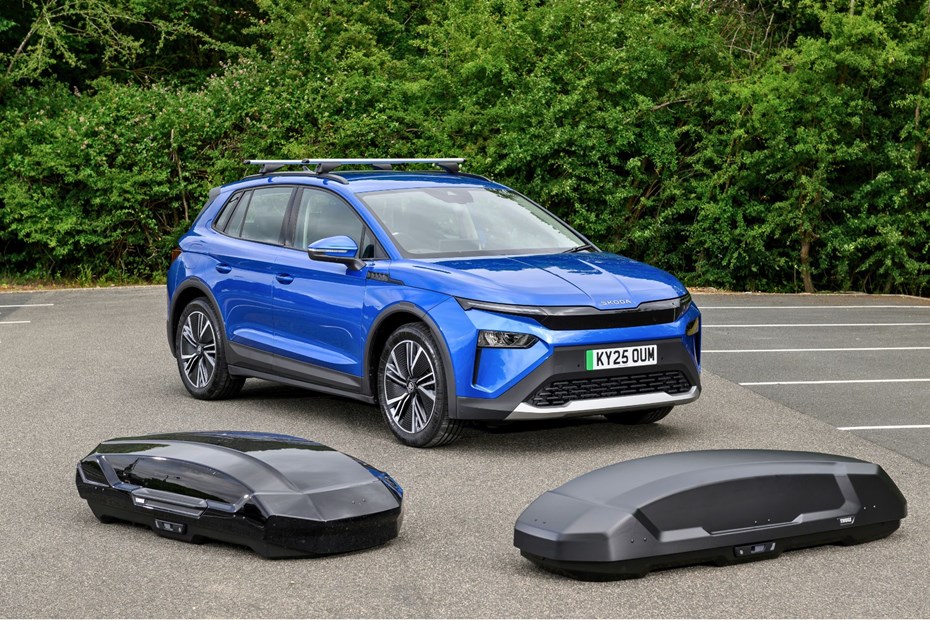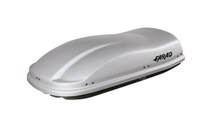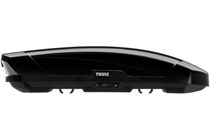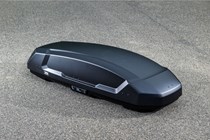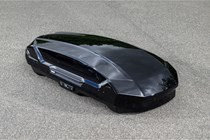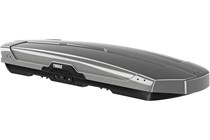If you’re in need of some extra storage for your next summer road trip, car roof boxes can make the difference between an easy trip and one that you’ll regret slightly. They provide a few hundred litres of extra storage space on a part of your car that would otherwise be unoccupied, the roof. These hinged boxes open up and can easily store suitcases, boxes and other items that eat up valuable cabin space when packing for a camping holiday or road trip.
Naturally, you’ll need roof racks before fitting either a roof box or a roof bag. It’s also worth keeping in mind the space you need to store your roof box when it’s not installed on your car. After all, an empty roof box will do nothing but spoil your fuel economy, so it’s a good idea to use it only when required.
How to choose the right roof box
Choosing the right car roof box isn’t only about picking the biggest one you can find; it’s about matching the box to your needs and your vehicle. Think about how much extra storage you require and that the roof box mounting system suits your car model. You’ll need to make sure the box is made from tough, weather-resistant materials, and choose a design that’s simple to fit so you can spend more time driving and less time setting up.
Capacity considerations
One of the first things you need to consider is size. Roof boxes typically range from around 250 to 500 litres, so think about what you’ll be carrying. If you’re transporting bulky gear like skis or camping equipment, a longer, slimmer box might work best. For family road trips, a larger box offers more space for luggage, but remember that bigger isn’t always better, as overloading your car can affect fuel economy and handling. Always check your vehicle’s roof load limit before deciding on size.
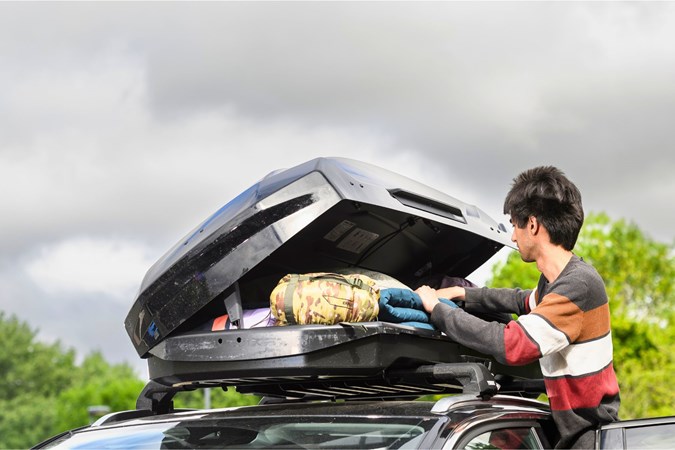
Compatibility with different vehicles
Make sure to choose a roof box that’s compatible with your car, since they don’t all fit every vehicle. You’ll find that some models come with universal fittings that work with most cars, while others are designed for specific bar shapes or spacing. It’s also worth thinking about how the box opens. If you have a taller vehicle, side-opening boxes can make it much easier to reach your gear. For wider cars, dual-side opening is really handy since you can access your stuff from either side. Don’t forget to double-check the weight limits and clearances, too – this helps you avoid any headaches with your tailgate or aerial getting in the way. Taking a few minutes to verify these details upfront will save you time and ensure everything works smoothly.
Material durability
Your roof box is going to be facing all sorts of weather, so you’ll want something that can really stand up to the elements. Most quality boxes are made from ABS plastic or similar materials that offer strength without adding too much extra weight. A UV-resistant finish will help keep your box looking good even after years of sun exposure. You’ll also want to check that the hinges are well-reinforced, as these tend to get the most use over time. If you’re planning to travel through particularly tough conditions, it’s worth investing in a box with a thicker shell and a solid locking system. This extra protection will give you peace of mind knowing your gear will stay completely safe and dry, no matter what Mother Nature throws at you.
Ease of installation
You don’t want to waste valuable holiday time faffing around, so look for a roof box that goes on quickly and securely. Many modern designs feature tool-free mounting systems, allowing you to install the box in minutes. If you’re someone who takes the box on and off regularly, features like quick-release clamps or power-click systems can be real time-savers. They make the whole process so much smoother and less of a hassle. A good design will also include clear indicators to confirm it’s locked in place, giving you confidence on every journey.
The best roof boxes tested 2025 at a glance
Types of roof boxes explained
Roof boxes aren’t one-size-fits-all; there are several types designed for different needs. From compact boxes for everyday storage to long, slim options for skis and snowboards, and even extra-large models for family trips, each style offers its own advantages. Understanding the different types will help you choose a box that suits your vehicle, your lifestyle, and your budget.
Long vs short roof boxes
Long roof boxes
Best for: Winter sports, fishing, and camping gear. Long roof boxes are designed to accommodate skis, snowboards, fishing rods, and other lengthy items. They usually range between 190 and 230 cm in length, making them perfect for outdoor enthusiasts.
Short roof boxes
Best for: Extra luggage space for everyday trips. Shorter roof boxes typically measure 110 to 150 cm in length and are focused on maximising storage for bags, groceries, or smaller gear. They’re a great choice for smaller vehicles or when you don’t need the extra length.
Soft-shell vs hard-shell roof boxes
Soft-shell roof boxes
Best for: Occasional use, light luggage, easy storage. Soft-shell roof boxes are typically made from durable, weather-resistant fabric. They’re flexible, lightweight, and can be folded down when not in use – perfect if you have limited storage space at home.
Hard-shell roof boxes
Best for: Frequent use, maximum security, and all-weather travel. Hard-shell boxes are rigid and typically made from ABS plastic or similar materials. They offer superior durability and security, making them ideal for regular travellers and outdoor enthusiasts.
Aerodynamic vs high-capacity designs
Aerodynamic roof boxes
Best for: Long-distance driving, fuel efficiency, and reduced noise. Aerodynamic designs are slim and tapered at the front to cut through the air, reducing wind resistance and noise. They’re perfect for regular drivers who want extra storage without sacrificing too much on performance or economy.
High-capacity roof boxes
Best for: Family holidays, camping trips, and bulky gear. High-capacity boxes prioritise storage over aerodynamics. They’re taller and wider, offering the maximum possible volume and are ideal for big family trips or carrying irregularly shaped items.
How to choose the right roof box for your car
Choosing the perfect roof box is all about finding that balance between size, compatibility, and safety. Start by thinking about your storage needs, the kinds of trips you will be taking and how much gear you typically bring along. Next, you’ll want to take a look at your roof bar system, since most boxes need these to attach securely to your car. Don’t worry if you don’t have them yet – they’re usually straightforward to add. Finally, it’s always smart to check your car’s weight limits and make sure you’re following UK road regulations. Taking a moment to verify these details means you can enjoy your adventures knowing you’re travelling safely and legally.
Size and capacity – what fits your car and lifestyle?
When choosing a roof box, think about what you’ll be carrying and how often you’ll use it. For everyday storage or short trips, a compact box (around 250 to 350 litres) works well. Families or campers may need a medium to large box (400 to 600 litres) for extra luggage. Remember to measure your car’s roof and ensure the box won’t block your boot opening or overhang excessively. Bigger isn’t always better, as extra weight and wind resistance can affect fuel economy and handling.
Roof bar compatibility: Do you need them?
Most roof boxes require a set of roof bars or crossbars to attach securely to your vehicle. Some cars come with factory-fitted bars, while others will need to be fitted with an aftermarket option. Check the mounting system on the roof box, as many use universal fittings, but some require specific bar types or spacing. If you don’t have roof bars, you’ll need to factor in this additional cost before buying a roof box.
Weight limits and legal restrictions in the UK
Your roof box should never exceed the maximum roof load (usually referred to as the static roof load) stated in your car’s manual. This includes the weight of the box itself and the contents inside. In the UK, there’s no specific legal weight limit for roof boxes, but overloading can affect handling, braking, and insurance. As a rule of thumb, keep your total roof load under 75kg unless your manufacturer specifies otherwise. Distribute weight evenly and secure all items to avoid shifting during travel.
We love the extra versatility these things can provide, sometimes doubling a car’s storage capacity. That’s why we’re bringing you the best roof boxes for your next big trip. And if you’re stuck for somewhere to place your bikes, have a look at our guide on the best bike racks for your car.
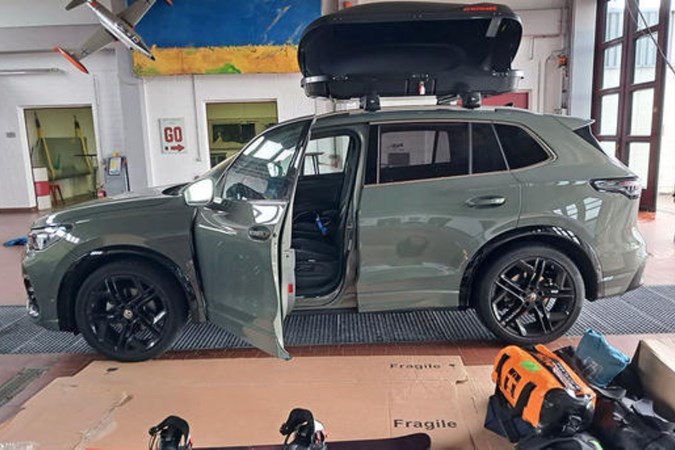
How we test
Each roof box we called in was tested using a series of vehicles on the Parkers long-term fleet. This included a Skoda Elroq, Dacia Duster, Audi A5 Avant, and Volkswagen ID.7 Tourer.
Our testing was performed in collaboration with Live for the Outdoors, to which we used group outdoor editor, Oli Reed’s Peugeot 3008 as another test bed for the roof boxes. We had a look at each box based on a number of factors: the first was practicality and functionality – whereby we loaded up each one with camping equipment to see how easily each one swallowed it up.
The next involve build quality and security: each are massively important given you’ll be mounting these things on top of your vehicle, so things like locking mechanisms and fastenings are crucial for passing the Parkers test. Any fiddly straps or low-quality components get an instant deduction in points.
You will most likely be travelling long distances, so knowing that your roof box can hold itself together and keep your possessions safely secure is hugely important, especially when travelling up to 70mph on the public highway – all of these factors were assessed with a stern eye.
We also partnered up with our German friends, Auto Zeitung to share the results of a thorough and comprehensive roof box test they performed with a number of different makes and models.
The team had a realistic criteria to judge their findings on. The roof boxes were attached to the top of a Volkswagen Tiguan 1.5 eTSI, which was supported by Volkswagen roof rails and support rods from the marque’s accessories range.
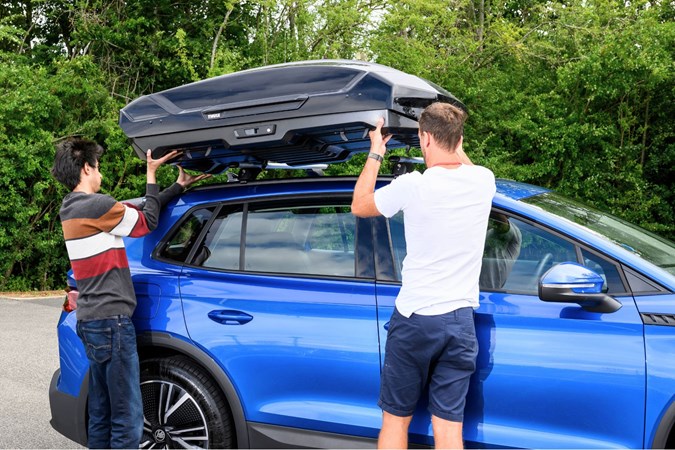
With the petrol tank filled to the brim and not accounting for a driver and 140kg of luggage, the basic weight of the Tiguan is 1,637kg. The maximum roof load on the vehicle is 75kg, and this was taken into account throughout the test. From sleeping bags to pillows and even skis, Auto Zeitung’s test team used a variety of equipment to make up a realistic load of what you might put in a roof box on a summer holiday.
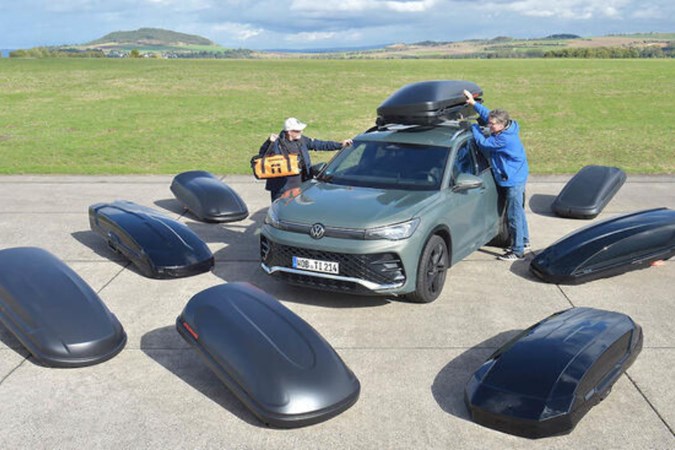
What we look for in roof boxes
We should also point out that while our friends at Auto Zeitung pitted up eight roof boxes in their test, not all of them are easily available in the UK marketplace. We’ve done what we can to carry across as much information as possible on those that are available, and labelled those that were tested by our continental colleagues.
To add a bit of flavour, we’ve also included a selection of roof boxes that were carefully chosen and recommended by the Parkers team, giving you more choice and things to consider when buying your next roof box.
Meet the experts
Aaron Hussain
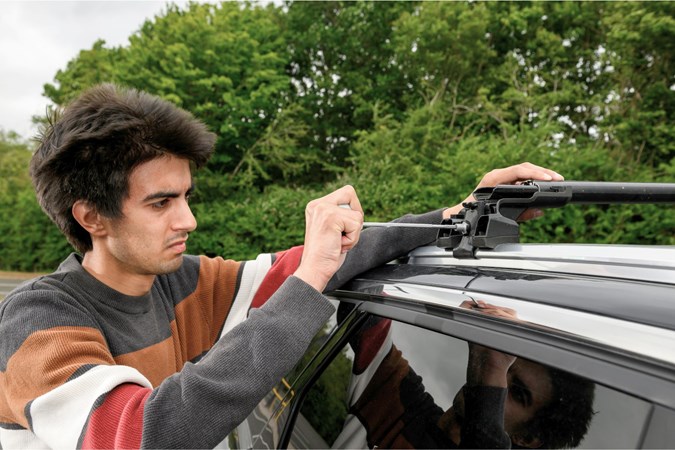
Joining Parkers in 2023 as a Commercial Content Writer, Aaron is a serial tester of many products, ranging from car shampoo to dashcams and now, roof boxes. He has coordinated many product group tests on Parkers and sister site, CAR Magazine, and has an eye for detail when assessing things for people’s needs.
Adam Binnie
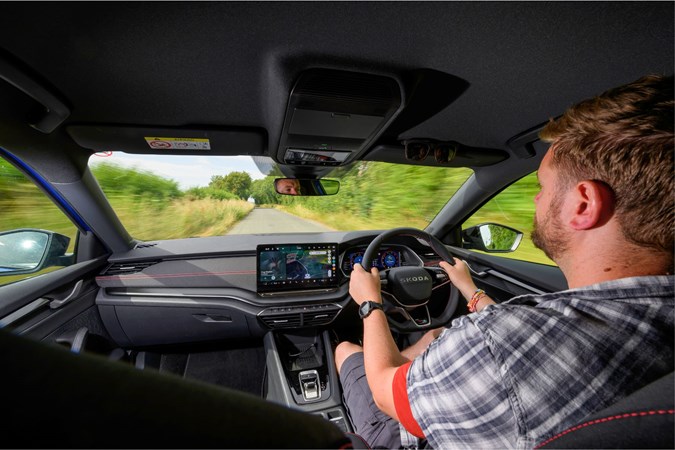
Adam has been with Parkers since 2015 and has since gone from New Cars Editor to Affiliate Operations Editor, looking after the commercial content side of things. He is massively into mountain biking, camping, and pretty much anything to do with roof boxes.
As a serial camper, he is more than qualified to assess roof boxes to their full potential. He’s taken a series of them as well as roof bags on regular holidays, so he knows exactly what to look for.
Oli Reed
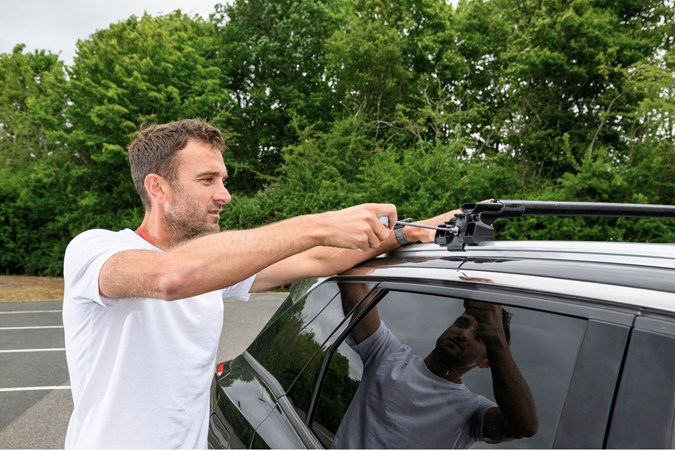
Group Editor for Live for the Outdoors, Oli is a lifelong hiker who has climbed many peaks including the Dolomites, Yosemite, and even the humble Lake District. He is passionate for anything outdoors and loves a spot of camping, cycling, and paddling.
Suffice to say, an individual that enjoys outdoor activities is more than qualified to check out some of the very best roof boxes. He’s always a Thule Motion 3L installed on top of his car and it’s rarely seen without camping equipment loaded up inside.
The best roof boxes for a summer holiday tested 2025
Tested by Parkers
The best roof box
When presented with the Motion 3, it was already loaded to the brim with equipment. Everything from sleeping bags to air mattresses and even the odd pillow, the Motion 3M swallowed it all up like it was lunch – and with plenty of clearance left.
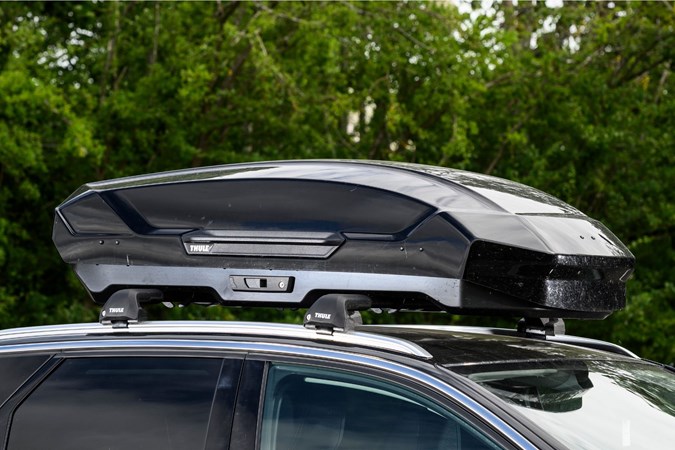
Like the Force 3, the locking mechanism feels solid and shuts with plenty of reassurance. You can also open it from both sides, so there’s no trouble if you park next to a wall at your holiday destination.
Do I wish it was more aerodynamic? Yes. But would I yearn for more room if that was the case? Again, probably so. These are just the consequences you have to deal with when choosing a roof box. But overall, the Motion 3 remains one of the best picks that money can buy.
Review by Aaron Hussain
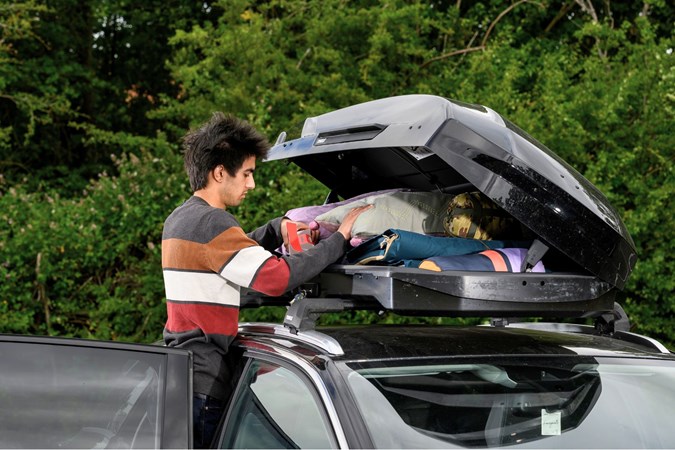
Second opinion, Auto Zeitung - Thule Motion 3 Large
Stunning our German friends, too. The Thule Motion 3L will happily accommodate what most people need for their roof box. With sterling build quality and profound space and practicality, the Motion 3L can swallow up skis up to three-metres long, while happily accommodating other useful things, too.
The total capacity is 450-litres and can take a load of weight. It's hardened shell means its durable in all conditions, and you can spec it with an interior light box, a pull strap for easier access inside and even a protective liner.
Pros
- High quality materials and solid construction - even the locks feel reassuringly tight
- Plenty of space at 400L of capacity, which allows a myriad of things to be stored inside
- Should be large enough for most applications, including both summer and winter holidays
Cons
- The Alpine version and other Thule models are more aerodynamic
- Slightly heavier than others at 17kg before loading it up with things
| Capacity | 400L |
| Dimensions | 175 x 84 x 44cm |
| Weight | 17kg |
| Total payload | 75kg |
Tested by Parkers
Editor's pick
It’s quite a shallow box; the rails and grooves at the bottom mean you can’t necessarily get a lot of thick equipment inside without giving the lid a push. It’s primarily designed for skis and winter holidays, so perhaps your summer getaway might present more of a challenge.
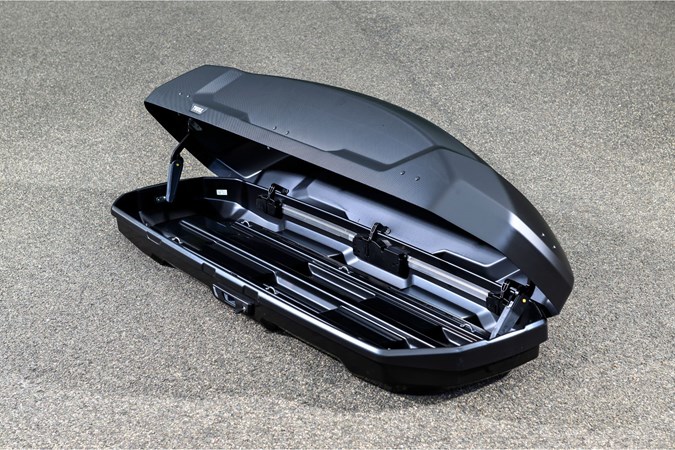
It still boasts 450-litres worth of space with a 75kg payload. That's exactly the same on paper as the Motion 3L, but we found that because it's a bit longer and sleeker, you'll have to be slightly cleverer with packing.
Nevertheless, the feel and quality of the box feels reassuringly robust. The locking mechanism feels solid, and it opens up from both sides for extra convenience. With a helping hand, it’s also quite easy to fit onto a set of Thule roof bars.
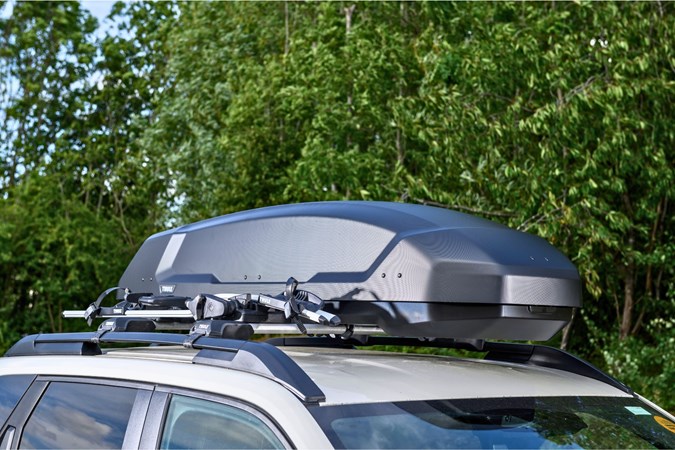
Overall, if I was after a roof box myself, this would be on my shortlist. The quality, design, and ergonomics of the Thule Force 3 exceed the brand’s own Motion 3. It’s not just an ideal roof box for the summer getaways, but easily the winter ones as well.
Review by Aaron Hussain
Pros
- Sleek, modern design which has an attractive carbon fibre effect
- Superb build quality and materials - complimented by a secure locking mechanism
- Easy to fit onto a set of Thule roof bars and very practical, although floor isn't completely flat
Cons
- Isn't quite as practical as the Motion 3L, but is more aerodynamic
| Capacity | 450L |
| Dimensions | 195 x 84.5 x 42.5cm |
| Weight | 18.7kg |
| Total payload | 75kg |
Tested by Auto Zeitung
Editor's pick
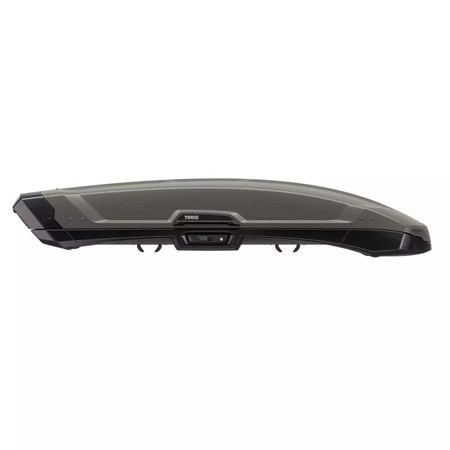

There are, however, a few drawbacks. The box itself without anything in it is 30kg - making it twice as heavy as the lightest roof box the team had on test. And when opening it up after rainy conditions, water beads tended to sneak inside and damage the felt. This is something to bear in mind, in case you pack items such as blankets or pillows.
Pros
- Great build quality and materials, as expected with the Thule brand
- Swallows up skis and boards over two-metres long
- Weatherproof against rain and snow, which makes it great for winter breaks
Cons
- Substantially heavier than the others at 30kg before loading
- Water drips can damp the inner felt and potentially your possessions
| Capacity | 430L |
| Dimensions | 231 x 88 x 35cm |
| Weight | 30kg |
| Total payload | 75kg |
Tested by Auto Zeitung
The best value roof box
Chief among which was a plastic key that locks up the mechanism. Those and the fiddly tension straps gave the impression that the Marlin 400L isn't the most durable roof box available. It does regain a few points by offering up to 400-litres of space and it does take a high payload of items.
Pros
- Takes a high payload of items at 75kg, which is comparable to the Thule boxes
- Good value for money compared to the Thule boxes
- Relatively roomy, but not ideal for longer skis and boards
Cons
- Low quality key and locking mechanism
- Straps are very fiddly, which is annoying when installing and opening it
| Capacity | 400L |
| Dimensions | 160 x 80 x 40cm |
| Weight | 23kg |
| Total payload | 75kg |
Tested by Auto Zeitung
Best value medium-sized roof box
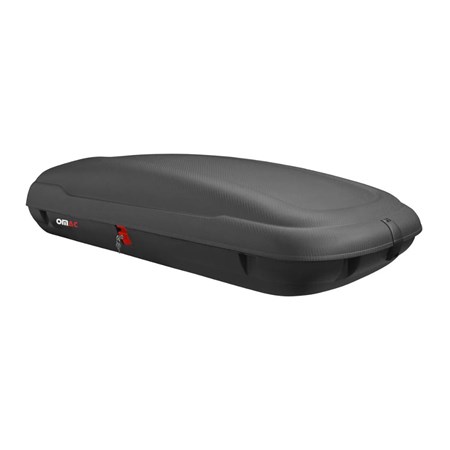

However, there are quite a few downsides. A fiddly locking system, fragile screw slides, and only being able to accommodate skis up to 1.5m long mean the OMAC is not a top contender in our colleagues' test.
Pros
- Good amount of space overall, but doesn't take longer skis
- Good value for money compared to others
- Additional locking bolt at the front of the box
Cons
- Doesn't come with tension straps, nor is it even pre-assembled
- Has a low loading height
| Capacity | 400L |
| Dimensions | 169 x 79 x 37.5cm |
| Weight | 11kg |
| Total payload | 75kg |
Recommended by Parkers
Best value large roof box
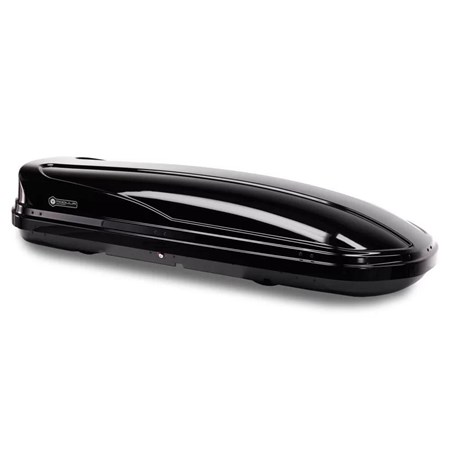

Designed with aerodynamics in mind as well as practicality, the Wego shouldn't affect your fuel economy too much with its sleek design. Partner this with a dual opening mechanism for maximum versatility, and the Wego really is a great option for big families and/or long trips.
Pros
- Huge storage capacity of 500L, which supercedes most Thule boxes
- Very easy to install, which helps with usability
- Quite aerodynamic which helps with fuel economy and wind noise
Cons
- Overkill for smaller cars and loads
- Only really suitable for larger cars
| Capacity | 500L |
| Dimensions | 198 x 80 x 38cm |
| Weight | 16.9kg |
| Total payload | 75kg |
Recommended by Parkers
Best roof box for small cars
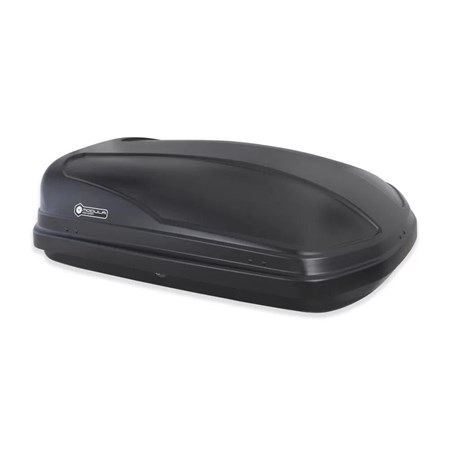

More affordable than the premium options but still made of UV-resistant materials, the Ciao is best suited to smaller cars offering 340 litres of capacity. It may only open on one side, but it still represents excellent value for money.
Pros
- Good enough quality for the asking price
- Lightweight at just 10kg before loading it up
- Great value for money at a hair under £200
Cons
- Not the biggest capacity available at a mere 360L, so you can't get everything inside
| Capacity | 340L |
| Dimensions | 140 x 80 x 44cm |
| Weight | 11kg |
| Total payload | 75kg |
Recommended by Parkers
Best roof box for aerodynamics
Beyond this, the Motion XT Alpine features all the other Thule features that make it such a clever purchase. The PowerClick quick mounting system makes installing the roof box simple, while the SlideLock will automatically lock the roof box once the lid is closed. It can even fit in skis up to two-metres long or slightly more.
Pros
- Aerodynamic design which is great for wind noise and fuel economy
- Huge storage capacity of 450L, albeit in a sleeker package
- Great quality box as per the Thule brand and qualities
Cons
- Hefty weight at 25kg before loading it up - and skis aren't light
| Capacity | 450L |
| Dimensions | 232 x 95 x 35cm |
| Weight | 32kg |
| Total payload | 75kg |
Recommended by Parkers
Best small aerodynamic roof box
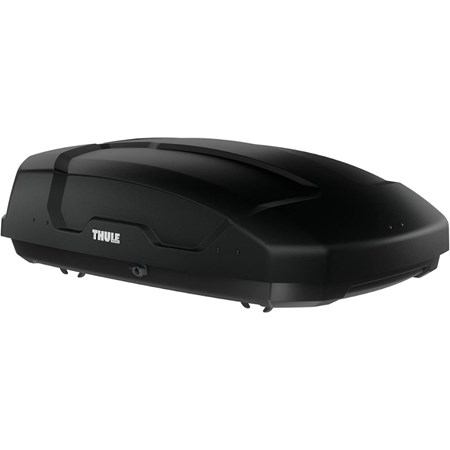

You get 300 litres of storage, and it's designed to be just that little bit more aerodynamic than your average small roof box. It even comes with its own Thule-specific key for a bit of extra security, too. It's also relatively compact at just 139 x 89.5 x 39cm, which is useful if you only have a small car to attach your roof box to.
Pros
- Quite aerodynamic and compact, which is great for shorter breaks
- Offers pretty good storage for the money (300L worth)
- Good for lots of cars, including small hatchbacks
Cons
- Isn't the most extensive in terms of space with a volume of 300L
| Capacity | 300L |
| Dimensions | 139 x 89.5 x 39cm |
| Weight | 14kg |
| Total payload | 75kg |
Roof box installation and safety tips
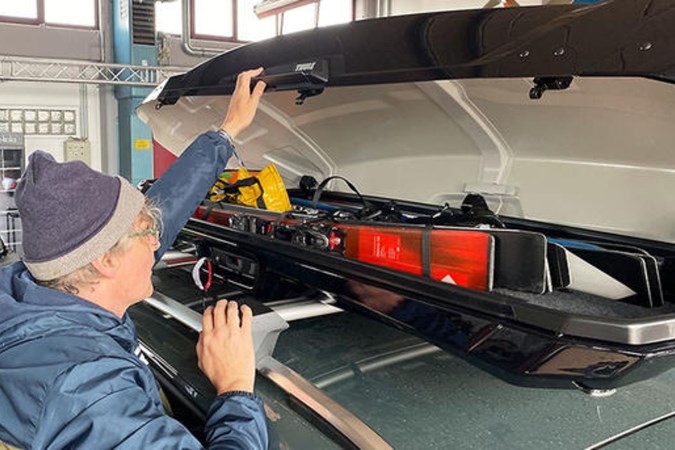
Fitting a roof box correctly and driving safely with it are just as important as choosing the right one. Poor installation, overloading, or incorrect driving habits can all affect your car’s stability and lead to accidents. Let’s look at how to mount a roof box safely, some tips for driving with a loaded roof box, and common mistakes to avoid so you can enjoy your journey with confidence.
How to mount a roof box safely
Start by reading the manufacturer’s instructions, as each model has its own mounting system. Place the box centrally on the roof bars to keep the load balanced and to reduce wind resistance. Use all the provided clamps or fixing points and tighten them securely. Most modern boxes feature quick-fit systems or safety indicators that click or change colour when properly attached – always double-check these. Finally, give the box a firm shake before driving to ensure it’s locked and stable.
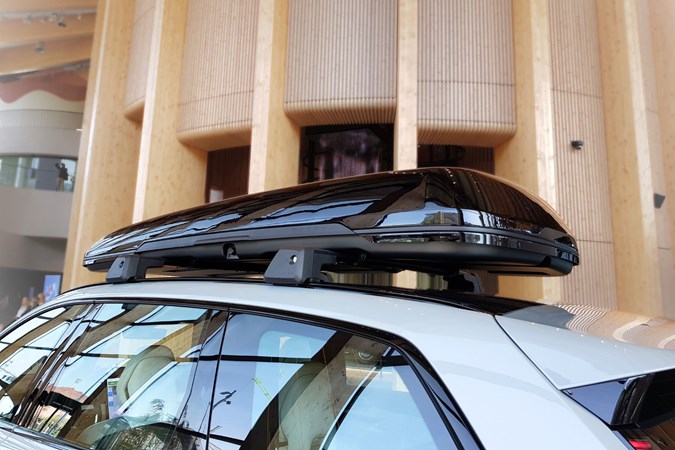
Tips for driving with a loaded roof box
A roof box changes your car’s height, weight distribution, and aerodynamics, so adjust your driving accordingly. Reduce speed on motorways to minimise wind noise and drag, and allow more time for braking as extra weight affects stopping distances. Take corners smoothly to avoid body roll and be cautious in strong crosswinds. Don’t forget to check clearance for car parks, garages, and height barriers as your vehicle is taller than usual.
Common mistakes to avoid
Overloading the roof box: Never exceed your car’s roof load limit or the box’s maximum weight.
Uneven packing: Distribute interior weight evenly to prevent the box from shifting while driving.
Ignoring security checks: Always lock the box and check it’s secure before every trip.
Not removing when not in use: Leaving a box fitted when you don’t need it wastes fuel and can cause wear on the box, fittings and your car.
Not considering the weather: In high winds, empty or remove the box if possible to avoid strain on the fixings.
How much should you spend on a roof xox?
Roof boxes range widely in price, from affordable entry-level options to premium models with advanced features. How much you should spend depends on how often you plan to use it, the type of trips you take, and what features matter most. Understanding the differences between budget and premium models will help you decide what offers the best value for your needs.
Budget vs premium roof boxes – what’s the difference?
Budget roof boxes (typically £150 to £300) are great for occasional use and light loads. They often have simpler fittings, less aerodynamic shapes, and thinner materials. Premium boxes (£400 to £900 and above) offer stronger construction, better security, dual-side openings, and sleek, aerodynamic designs that reduce wind noise and improve fuel efficiency. Premium options also tend to last longer, making them a better choice for frequent travellers.
Are cheap roof boxes worth it?
If you only need a roof box a few times a year, a budget option can be ideal. Just make sure it’s from a reputable brand and meets safety standards. However, if you’re planning regular long-distance trips or need maximum security and durability, investing in a higher-quality box will save money in the long run and give you peace of mind on the road.
Maintenance and storage
A roof box is an investment, and if you look after it, it can last for many years. Keeping it clean and storing it correctly when not in use will protect it from damage, maintain its appearance, and ensure it’s ready for your next trip.
How to clean your roof box
After each trip, thoroughly clean your roof box to remove dirt, dust, salt, and other road grime. Use a mild car shampoo and soft sponge, avoiding harsh chemicals or abrasive pads that can damage the finish. Rinse well and dry with a microfiber cloth to prevent water spots. While you’re doing this, it’s a good idea to apply a light lubricant to the locks and hinges to keep them smooth and rust-free.
Best practices for storing your roof box when not in use
When it’s not in use, store your roof box in a cool, dry place away from direct sunlight to prevent fading and warping. If you have space, hang it on a wall or ceiling using a roof box hoist. This saves room and prevents scratches. Always keep it locked when stored to protect the hinges and maintain alignment. Avoid stacking heavy items on top of the box, as this can cause cracks or distortions.
FAQs
-
Can I use any roof bars with a roof box?
No, not all roof bars are compatible with all roof boxes. It's important to make sure that the roof bars you have or plan to purchase can securely fit the roof box model you choose.
-
Is it safe to leave a roof box on the car all the time?
While it is safe to leave a roof box on your car, it’s not always recommended. Leaving it on can impact fuel efficiency due to increased drag and may expose the box to weather damage or theft. If you’re not using it frequently, it’s best to remove and store it.
-
How does using a roof box affect my car's fuel efficiency?
Using a roof box increases aerodynamic drag, which can reduce your car’s fuel efficiency by up to 10-25%, depending on the size and shape of the box.
Roof boxes come with the extra weight and compromised aerodynamics. You might notice, therefore, that your fuel economy will be hindered. This is because they sit directly on your roof which affects airflow when in motion, causing drag. This causes the engine to work harder - especially when fully loaded - and thus, reduces fuel economy. Some roof boxes are designed with aero in mind, such as the Thule XT Alpine, and these are generally more ideal for skiing trips due to their longer profile. -
Do I need to inform my insurance company if I use a roof box?
It is advisable to inform your insurance company if you use a roof box, as it might affect your coverage. Some policies require notification of any modifications or additions to the vehicle that may impact its handling, security, or value.
-
Can I drive through car washes with a roof box?
In most cases, no. It’s not recommended to take your car through an automatic car wash with a roof box attached. The rotating brushes and water jets can damage the roof box, loosen its fittings, or even rip it off entirely. If you need to clean your vehicle, either remove the roof box first or opt for a touchless car wash that uses water jets without physical contact. For the box itself, hand washing is always the safest option.
-
Can I use a roof box without roof bars?
No, roof bars (or crossbars) are essential for fitting a roof box securely. Roof boxes are designed to attach to these bars, which provide a stable base and distribute the weight evenly across your vehicle’s roof. Without them, there’s no safe way to mount the box, and attempting to do so could damage your car and create a serious road hazard. If your car doesn’t have factory-fitted roof bars, you’ll need to purchase an appropriate set before using a roof box.
Sign up to the Parkers Newsletter to keep up to date with more of the latest reviews, news, and recommendations from the Parkers team.
Just so you know, we may receive a commission or other compensation from the links on this website - read why you should trust us.


